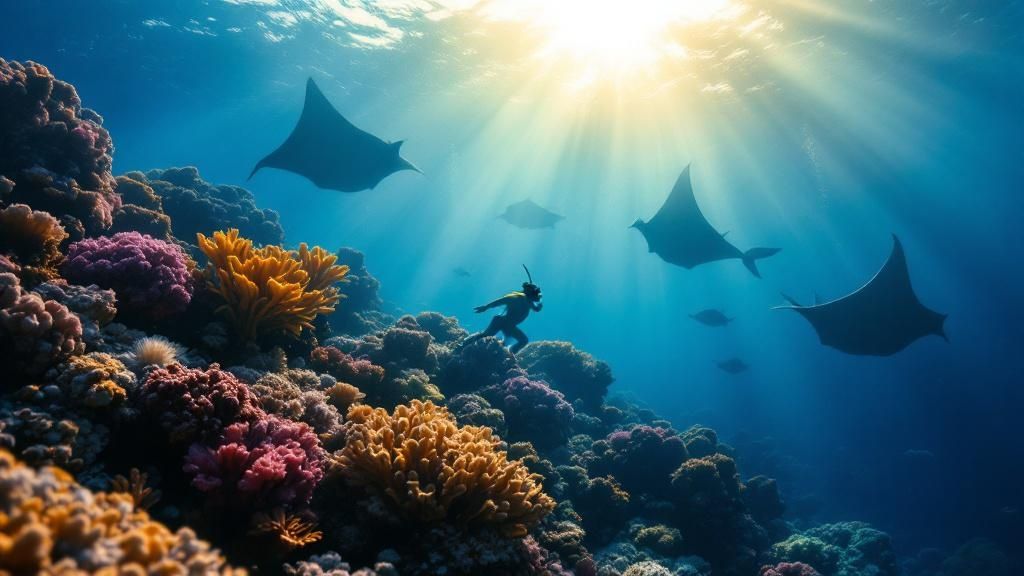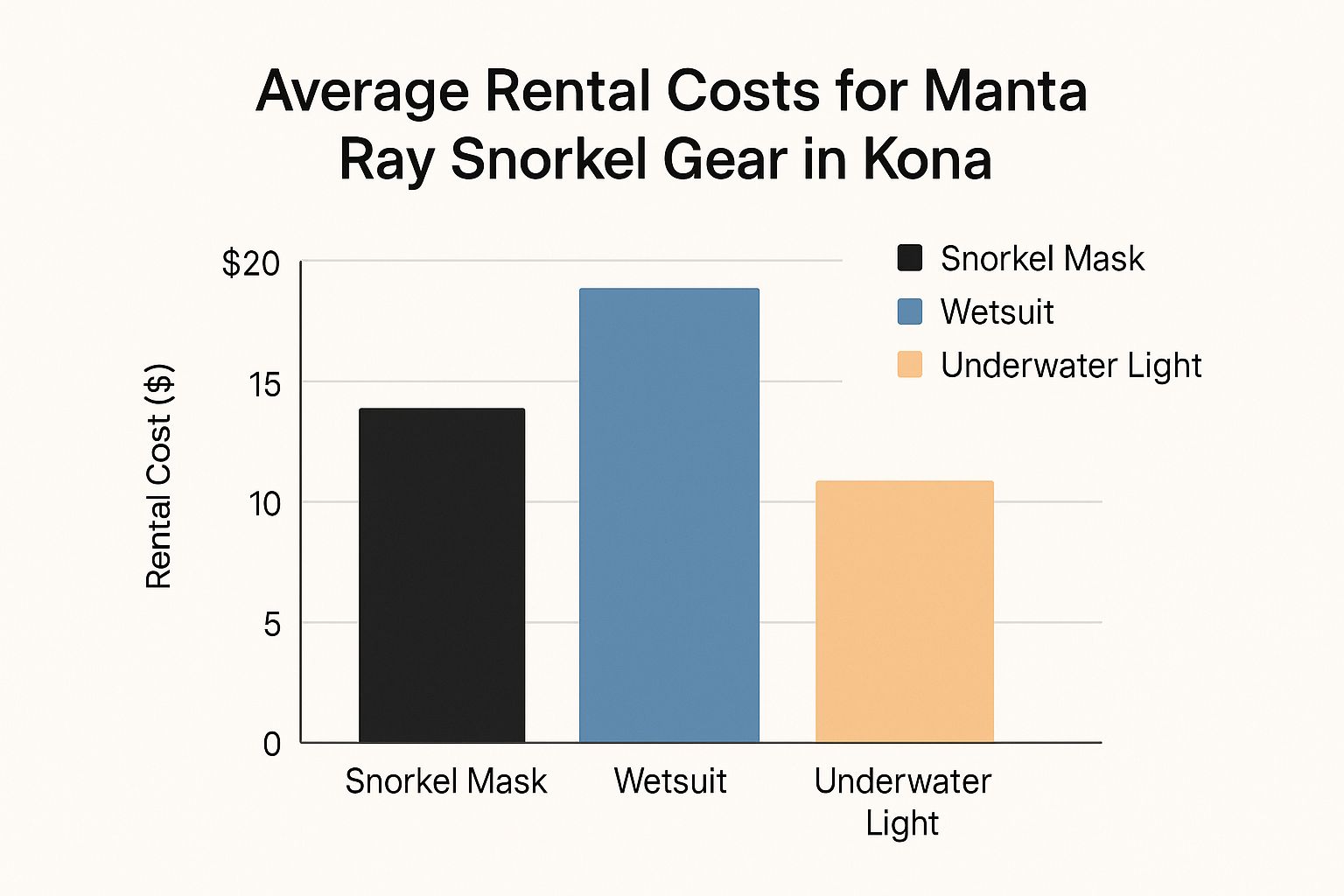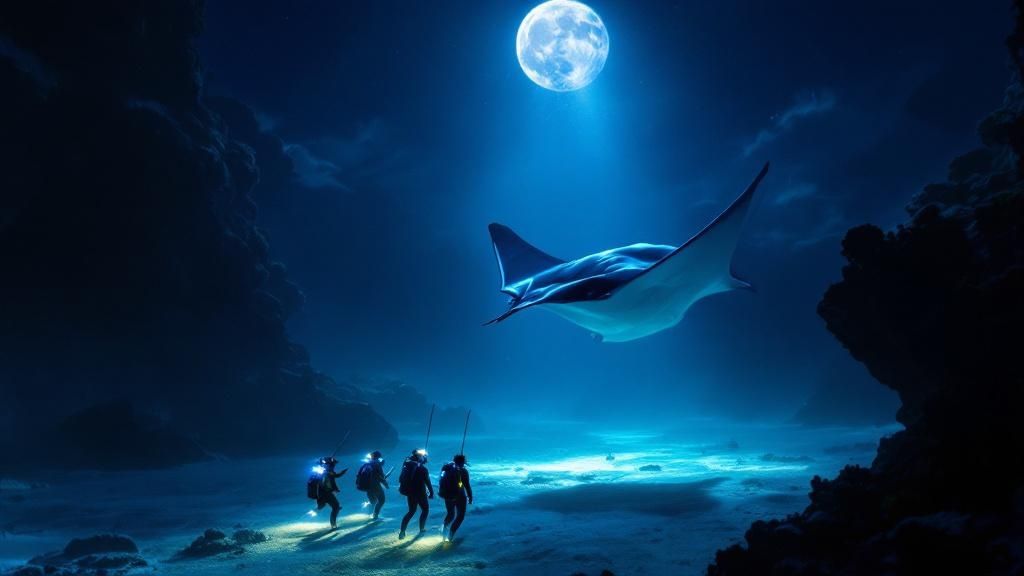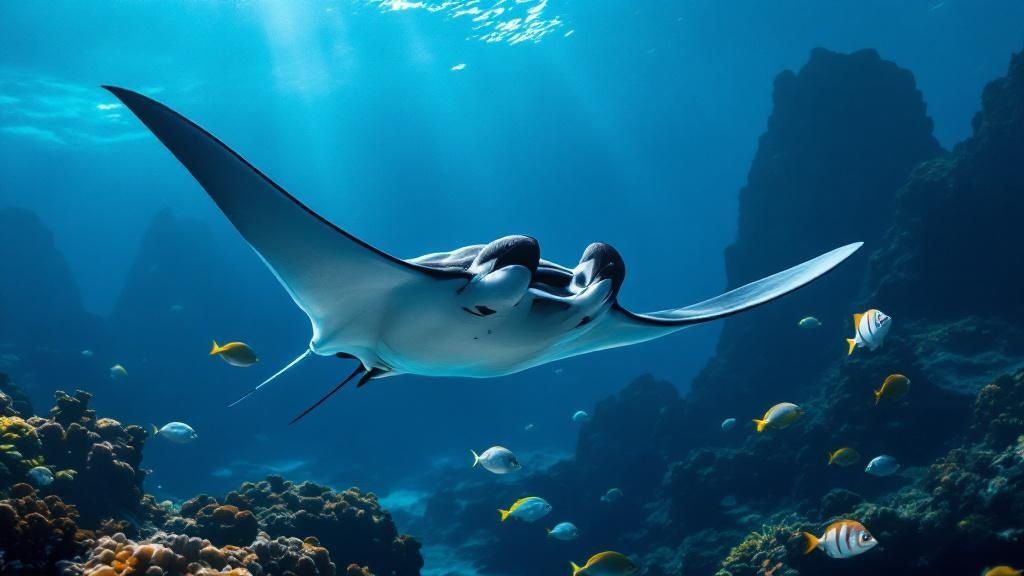Manta Ray Snorkel Kona Guide: Night Adventure Secrets
- Byron
- Jun 10
- 13 min read
Why Kona Creates The World's Most Magical Manta Encounters
Imagine yourself floating in the warm Pacific Ocean, surrounded by gentle giants with 20-foot wingspans. They glide effortlessly around you, like underwater ballet dancers. This isn't a fantasy; it's a typical night in Kona, Hawaii. But what makes this specific coastline such a haven for manta ray night snorkeling? It’s a fascinating combination of factors that creates a true manta ray paradise.
The island's volcanic topography plays a critical role. Ancient lava flows have sculpted a unique underwater world, filled with crevices and ledges. Think of these formations as underwater "condos" for small fish, who set up shop and offer cleaning services to the mantas. These fish nibble away parasites, acting like tiny spa attendants, creating a comfortable and enticing environment for the mantas to hang out.
The Big Island is also surrounded by nutrient-rich currents. These currents act like giant conveyor belts, carrying microscopic plankton, a manta ray's favorite food. It's an all-you-can-eat buffet delivered right to their mouths! This constant food source is essential for supporting a large and thriving manta ray population.
Interestingly, the volcanic rock itself contributes to this plankton feast. Minerals released from the rock act like a natural fertilizer, enriching the water and boosting plankton growth. It’s a perfect ecological cycle: volcanoes nourish plankton, and plankton attracts manta rays. This reliable food source makes Kona one of the most consistent places globally for manta ray sightings.
This rich environment creates an ideal location for Manta Ray Snorkel Kona: Unforgettable Hawaii Marine Tours. Roughly 80,000 people experience manta ray snorkeling in Kona annually. With sighting success rates between 80% and 90%, that means 8 to 9 out of 10 snorkelers are likely to see these magnificent creatures.
Finally, dedicated conservation efforts have been vital. Local regulations protect the manta rays and their habitat by limiting harmful fishing practices. This creates a sanctuary where the manta rays can flourish, making those magical encounters even more special for snorkelers. Kona's unique blend of geology, ocean currents, and human protection creates an unforgettable wildlife experience.
Decoding The Secret Lives Of Night-Feeding Mantas

Forget chance meetings in the vast ocean. Manta rays follow a carefully orchestrated feeding ritual, passed down through generations. These highly intelligent creatures have developed sophisticated feeding techniques, as graceful and precise as a ballet. They're not simply filtering plankton; they're actively pursuing it, using strategies to maximize their intake.
The Art Of The Manta Meal
One remarkable technique is barrel rolling. Picture a manta ray performing underwater somersaults, spiraling upwards through a dense cloud of plankton. This motion creates a swirling vortex of food, allowing the manta to efficiently gather massive quantities of plankton. It's like they're creating their own personal plankton buffet.
Another impressive strategy is chain feeding. Imagine multiple manta rays lining up nose-to-tail, gliding through a plankton bloom. This coordinated movement generates a current, each manta benefiting from the flow created by the one in front. Think of it like a perfectly synchronized conga line, ensuring everyone gets their fill of plankton.
The Allure Of Artificial Light
These natural feeding behaviors are amplified by the artificial lights used during manta ray snorkel Kona tours. The lights act like a beacon, drawing the plankton in and creating a concentrated feast. For the manta rays, it's like an all-you-can-eat buffet appearing right on cue. This makes the experience both predictable and plentiful for the mantas, and truly spectacular for snorkelers.
The Kona Coast, with its abundant manta ray population, has become a vital location for manta ray research. Between 2009 and 2014, scientists diligently tracked individual manta rays, carefully recording sightings and health data. This extensive research revealed critical information about their movements and population dynamics, allowing researchers to better understand when and where large groups of mantas might gather. For more information on this research, learn more about manta ray statistics.
Unique Spot Patterns: Nature's Fingerprints
Much like our fingerprints, each manta ray possesses unique spot patterns on its underside. These markings act like personal identification tags, enabling researchers to track individuals over decades. This provides invaluable data about lifespan, migration patterns, and population trends, all of which is essential for conservation efforts.
Social Dynamics: More Than Just A Meal
Manta ray feeding isn't solely about individual survival; it's a social occasion. These seemingly solitary creatures often congregate in groups to feed, demonstrating a surprising degree of social interaction. While the precise nature of these interactions remains a subject of ongoing study, it's evident that these gatherings are more than simply a shared meal.
A nighttime manta ray snorkel Kona experience offers a rare window into this complex ecosystem. It's a chance to witness firsthand one of nature's most elegant survival strategies in action. This unique combination of intelligence, social behavior, and perfectly timed feeding rituals makes manta rays truly mesmerizing. Want to plan your own Kona adventure? Check out our comprehensive guide to manta ray snorkeling for more information.
Choosing Your Perfect Manta Ray Adventure
Not all manta ray tours are created equal. Picking the right one can be the difference between a forgettable evening and a truly magical experience. It’s like choosing between a fast-food burger and a gourmet meal – both satisfy hunger, but the experience is vastly different.
Small Group vs. Large Boat: Finding Your Fit
One of the first things to consider is group size. A smaller group is like having a personal chef cater to your every need, offering a more personalized and intimate experience. With fewer people in the water, you'll have unobstructed views and the manta rays will be more relaxed. Larger boats, while often cheaper, can feel like a crowded buffet, impacting both your enjoyment and the manta rays’ natural behavior.
Asking the Right Questions: Unveiling the True Professionals
The tour operator's professionalism is paramount. Don't hesitate to ask questions – it's like checking the kitchen before ordering your meal. Ask about their safety procedures, their commitment to environmental responsibility, and how they choose their snorkel locations and times. A reputable operator will be happy to answer your questions and share their passion for these gentle giants. For more guidance on picking the right tour, take a look at our complete Hawaii adventure guide.
Snorkeling or Diving: Choosing Your Adventure Style
Next, decide between snorkeling and diving. Snorkeling, like admiring a coral reef from a glass-bottom boat, is easier and requires less equipment. It’s perfect for those who prefer a more relaxed approach. Diving, on the other hand, is like donning scuba gear and exploring the reef up close. It's a fully immersive experience, but requires certification and a higher comfort level in the water. The best choice depends on your personal preference and experience.
The Cost of Gear: Planning Your Budget
Before you jump in, it’s helpful to understand the cost of gear. Renting is usually the most practical option, and won’t break the bank.

This chart gives you an idea of what to expect. As you can see, renting the essential gear – mask, wetsuit, and underwater light – is surprisingly affordable. Think of it as a small investment for an unforgettable experience.
To help you compare different tour options, we’ve put together a handy guide:
Kona Manta Ray Tour Comparison Guide Essential comparison of tour types to help you choose the perfect manta ray experience
Tour Type | Group Size | Duration | Price Range | Included Gear | Best For |
|---|---|---|---|---|---|
Small Boat Snorkel | 6-12 | 2-3 hours | $150-$200 | Mask, Snorkel, Fins, Wetsuit, Light | Personalized experience, close encounters |
Large Boat Snorkel | 20-40 | 2-3 hours | $100-$150 | Mask, Snorkel, Fins, Wetsuit, Light | Budget-conscious travelers |
Private Snorkel Charter | Customizable | Customizable | $500+ | Often includes all gear | Families, small groups seeking exclusivity |
Dive Tour | 4-8 | 3-4 hours | $180-$250 | Requires personal dive gear, may include lights | Certified divers |
The table above highlights some key differences between the tours offered in Kona. Consider your budget, group size, and desired level of interaction with the manta rays when making your decision.
By considering these factors and doing a little research, you can choose a manta ray snorkel adventure in Kona that perfectly matches your needs and creates memories that will last a lifetime. You're not just booking a tour; you’re embarking on a journey into the magical world of these graceful creatures.
Gearing Up For Your Underwater Adventure
Success in a manta ray night snorkel in Kona starts with the right preparation. It's a bit like getting ready for a fancy dinner – you want to be comfortable, confident, and ready to savor every moment. Your “outfit” for this underwater ballet consists of a few key pieces.
Essential Gear: Your Underwater Ensemble
First up: the mask. A good fit is critical. A leaky mask is a constant nuisance, like a fly buzzing around your head, and will totally ruin the experience. Make sure to try on different masks before your tour to find the perfect seal. Next, you’ll need fins. They should propel you smoothly, like a gentle push in the right direction, not feel like anchors weighing you down. Choose fins that fit well and allow you to move efficiently without tiring your legs.

This image shows the essential snorkeling equipment. As you can see, the basics are pretty straightforward, making it an activity almost anyone can enjoy. The key is making sure each piece of gear fits correctly and works well, so you're comfortable and safe in the water.
Combating Fog: Keeping Your View Crystal Clear
Mask fog is the arch-nemesis of clear underwater vision. It's like trying to see through a frosted window – you miss all the beauty on the other side. You can prevent this by using defogging solution or a simple DIY trick: spit in your mask, rub it around, and rinse it with seawater. This creates a film that stops condensation from forming.
Wetsuit Wisdom: Staying Warm Under the Stars
While Hawaiian waters are generally warm, the temperature can dip, particularly at night. A wetsuit works like a cozy sweater, trapping a thin layer of water next to your skin to keep you warm. A 3mm or 5mm wetsuit is usually recommended, depending on the time of year and your personal preference. Some tours provide wetsuits, but bringing your own guarantees a perfect fit. For more information on this amazing experience, check out this post: Manta Ray Snorkel Kona Experience - Hawaii's Best Adventure.
Beyond the Gear: Mental Preparation
Getting ready isn't just about the physical gear. If you're new to snorkeling at night, try spending some time in a pool or shallow water after dark to get comfortable. Think of it as a test run before the big show, helping to ease any worries you might have about open water or the darkness. Imagine yourself gliding effortlessly among the manta rays, breathing calmly, and taking in the whole experience. This mental preparation can turn nervous excitement into pure joy and anticipation, setting the stage for a truly unforgettable encounter.
Staying Safe While Swimming With Giants
Night snorkeling with manta rays can seem a little intimidating at first. Imagine stepping onto a stage, but instead of bright lights, you're surrounded by the deep, dark ocean. However, with the proper safety measures, that initial apprehension quickly turns into pure excitement.
Think of it like a trust fall. That first moment of letting go can be nerve-wracking, but with strong, experienced hands below, you feel confident enough to lean back and enjoy the fall. Similarly, experienced manta ray guides have perfected their techniques over countless encounters, creating a system that keeps both you and these magnificent creatures safe.
One of the most common concerns is the darkness of the water. It's a bit like trying to navigate a dimly lit room – you might feel a little disoriented. But the guides are like expert navigators in this underwater world, constantly aware of everyone's position while ensuring you have the best view possible. This allows you to fully focus on the breathtaking display unfolding before you, knowing you're in capable hands.
The Buddy System and Emergency Procedures: Double Layers of Security
Most reputable tour operators use a buddy system. You're paired with another snorkeler, providing an added layer of safety in the water. It's like having a dance partner – you're there to support each other and make sure no one gets lost in the mesmerizing "dance" of the manta rays.
These operators also have established emergency procedures to handle a range of situations, from minor discomfort to more serious issues. Knowing these procedures are in place offers invaluable peace of mind, allowing you to fully immerse yourself in the experience.
Following the guide's instructions is paramount. It's similar to following a director's cues in a play – it ensures a smooth performance and everyone's safety. Guides provide specific instructions on how to maximize your encounter while respecting the manta rays and their environment. For a more in-depth look at this incredible activity, check out our ultimate guide to manta ray night snorkeling in Kona.
Physical Requirements and Staying Calm: Preparing for the Dance
While manta ray snorkeling isn't overly strenuous, a basic level of swimming ability is necessary. Think of it like learning a new dance step – it might take a little practice, but it's definitely achievable. You'll be floating on the surface with a flotation device, but being comfortable in the water is essential. The guides will openly discuss the physical requirements with you, so you'll know exactly what to expect.
Staying calm is key to truly enjoying the experience. Imagine trying to appreciate a stunning painting while feeling anxious – the worry distracts you from the beauty. In the same way, staying relaxed allows you to fully absorb the magic of the manta rays. Learn a few techniques for managing any potential anxiety in the water, and understand what to do if you start to feel uncomfortable or need help. Knowing your limits and pushing your comfort zone safely is essential for a memorable and rewarding experience.
Before you embark on your manta ray adventure, familiarize yourself with some essential safety guidelines. The table below provides a comprehensive overview of what to do and what to avoid to ensure a safe and respectful interaction with these gentle giants.
Essential Manta Ray Snorkeling Safety Guide
Critical safety protocols and guidelines for a secure and respectful manta ray encounter
Safety Protocol | Why It Matters | What To Do | What To Avoid |
|---|---|---|---|
Stay with your buddy and guide. | Enhances visibility and ensures quick assistance if needed. | Remain close to your designated buddy and follow the guide's instructions at all times. | Wandering off alone or lagging behind the group. |
Maintain a safe distance from the manta rays. | Prevents accidental contact and disturbance to their natural behavior. | Observe from a respectful distance, allowing the manta rays to approach you if they choose. | Touching, chasing, or cornering the manta rays. |
Avoid sudden movements and loud noises. | Startling the manta rays can cause them stress and disrupt their feeding patterns. | Move slowly and deliberately in the water. Keep your voice low and avoid splashing excessively. | Making abrupt movements, shouting, or banging on your snorkel gear. |
Do not shine lights directly at the manta rays. | Direct light can disorient and disturb these light-sensitive creatures. | Point your flashlight downwards or use red-filtered lights, which are less disruptive. | Shining bright lights directly into the eyes of the manta rays. |
Respect the ocean environment. | Protects the delicate ecosystem that supports the manta rays and other marine life. | Avoid touching coral or other marine organisms. Properly dispose of any trash. | Littering, standing on coral, or harassing marine life. |
By adhering to these safety protocols, you contribute to a positive experience for both yourself and the manta rays, fostering a deeper appreciation for these incredible animals and their ocean home.
Timing Your Visit For Maximum Magic

While manta ray snorkel Kona experiences are available year-round, understanding their behavior can greatly enhance your trip. It's like visiting a local market – you'll find something anytime, but certain days offer the best selection.
Seasonal Rhythms: Riding the Manta Ray Wave
Manta ray activity, much like migratory birds, follows seasonal patterns. These patterns connect to their food source: plankton. Plankton blooms depend on factors like water temperature and lunar cycles. Just as the moon influences the tides, it also affects plankton, creating periods of greater abundance.
The warmer months (April to October) typically have calmer, clearer water – ideal viewing conditions. This aligns with the dry season and its predictable weather. This increases the likelihood of a successful manta ray snorkel Kona experience. However, these are also the most popular months for tourism. Booking in advance is essential, like reserving a table at a popular restaurant. You might be interested in: Manta Ray Snorkel Kona: Top Tours & Experience Tips.
Moon Phases: Dancing with the Plankton
The moon significantly influences plankton behavior. A full moon brings plankton to the surface, creating a feast for the manta rays. Imagine a buffet suddenly illuminated – the increased activity provides exciting viewing opportunities.
Weather Patterns: Reading the Ocean's Mood
Weather, like a fickle friend, can impact your snorkel trip. While tours operate year-round, rough seas and rain can hinder visibility and even cause cancellations. Think of it like trying to read a book in a windstorm. Possible, but not ideal.
Booking Strategies: Securing Your Spot in the Underwater Ballet
Savvy snorkelers understand the importance of booking strategy. Reserve your spot weeks in advance, especially during peak season, to ensure you don't miss out. It's like getting tickets to a sold-out show – planning ahead is key.
Flexibility: Embracing the Unexpected
If possible, allow some flexibility in your schedule. This provides alternatives if weather affects your initial tour. Like having a backup restaurant in mind – if the first choice is full, you have another option. Flexibility lets you capitalize on ideal conditions, maybe even scheduling a second snorkel during a full moon.
By understanding these factors, you greatly improve your chances of a truly magical manta ray snorkel Kona adventure. It's more than just being there; it's about syncing your visit with the ocean's natural rhythms. This preparation turns a good experience into a lasting memory.
Your Complete Manta Ray Adventure Blueprint
Planning your manta ray night snorkel isn't just about booking; it's about crafting an experience. Think of it like planning a trip to see your favorite band. You'd check the venue, get your tickets in advance, and maybe even listen to their latest album to get pumped. Similarly, getting ready for your Kona manta ray snorkel involves some pre-show prep.
Planning Your Timeline: From Booking To Memories
Book your tour early, especially during the busy season (April to October). This not only guarantees your spot but also gives you breathing room to plan other parts of your trip. Ideally, aim for at least two weeks out from your target date. Pro tip: consider scheduling your manta ray snorkel at the start of your trip. Many operators offer a “manta guarantee” – meaning if you don't see mantas, you get another try for free!
Now, let's talk packing. Imagine showing up for a picnic without a blanket. Some essentials are easy to overlook! Your manta ray "essentials kit" should include:
Towel and dry clothes: You'll be grateful for these after your swim, especially when the evening air gets cooler.
Warm layer: Even in Hawaii, nights can get chilly, especially after getting out of the water.
Personal snorkel gear (optional): While tours provide gear, your own ensures a perfect fit and lets you practice beforehand.
Seasickness remedies (if needed): If boat rides aren't your thing, some medication or acupressure bands can ensure smooth sailing.
Preparing for the Big Day: Setting Yourself Up for Success
On the day of your tour, stay hydrated and have a light meal a few hours before. This helps avoid that sluggish or queasy feeling in the water. Arrive at the meeting point on time, ready for check-in and gear fitting. It's like getting ready for a sporting event - you want to be warmed up and ready to go!
Capturing Memories: Preserving the Magic
You'll definitely want to remember this experience, but try to focus on being present in the moment. If you bring a camera, make sure it's waterproof and securely fastened to prevent any accidental drops or disturbances to the manta rays. It's like watching a breathtaking sunset – soak it in first, then snap a photo.
Manta Ray Etiquette: Respecting The Gentle Giants
Once in the water, listen carefully to your guide. They're experts in manta ray behavior and will show you how to interact respectfully. Remember, no touching the manta rays! Their delicate mucous layer is essential for their immune system. Think of it like visiting a delicate art exhibit – look, but don't touch.
Extending the Impact: Beyond The Snorkel
Want to make your adventure even more meaningful? Consider supporting manta ray research and conservation. Many tour operators collaborate with organizations dedicated to protecting these majestic creatures. This turns your experience from a one-time encounter into a contribution to their future.
Ready for this incredible adventure? Book your Manta Ray Night Snorkel Kona Hawaii Tour and witness the magic yourself.
Comments